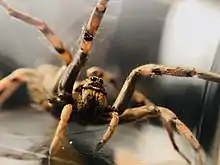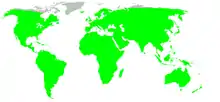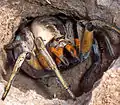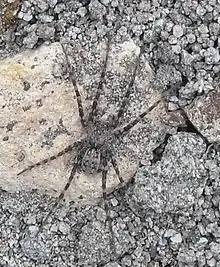Wolf spider
Wolf spiders are members of the family Lycosidae, from the Ancient Greek word "λύκος" meaning "wolf". They are robust and agile hunters with excellent eyesight. They live mostly in solitude and hunt alone, and do not spin webs. Some are opportunistic hunters pouncing upon prey as they find it or even chasing it over short distances. Some wait for passing prey in or near the mouth of a burrow.
| Wolf spiders | |
|---|---|
 | |
| Wolf Spider | |
| Scientific classification | |
| Kingdom: | Animalia |
| Phylum: | Arthropoda |
| Subphylum: | Chelicerata |
| Class: | Arachnida |
| Order: | Araneae |
| Infraorder: | Araneomorphae |
| Superfamily: | Lycosoidea |
| Family: | Lycosidae Sundevall, 1833 |
| Diversity | |
| 124 genera, 2888 species | |
 | |
Wolf spiders resemble nursery web spiders (family Pisauridae), but wolf spiders carry their egg sacs by attaching them to their spinnerets, while the Pisauridae carry their egg sacs with their chelicerae and pedipalps. Two of the wolf spider's eight eyes are large and prominent, which distinguishes them from the nursery web spiders whose eyes are all of roughly equal size. This can also help distinguish them from the similar-looking grass spiders.
Description

The many genera of wolf spiders range in body size (legs not included) from less than 10 to 35 mm (0.4 to 1.38 in).[1][2] They have eight eyes arranged in three rows. The bottom row consists of four small eyes, the middle row has two very large eyes (which distinguishes them from the Pisauridae), and the top row has two medium-sized eyes. Unlike most other arachnids, which are generally blind or have poor vision, wolf spiders have excellent eyesight.
The tapetum lucidum is a retroreflective tissue found in eyes. This reflective tissue is only found in the four[3] nonsmall eyes ("secondary eyes") of the wolf spider. Flashing a beam of light over the spider produces eyeshine; this eyeshine can be seen when the lighting source is roughly coaxial with the viewer or sensor.[4] The light from the light source (e.g., a flashlight or sunlight) has been reflected from the spider's eyes directly back toward its source, producing a "glow" that is easily noticed. Wolf spiders possess the third-best eyesight of all spider groups, bettered by jumping spiders of the family Salticidae (which can distinguish colors) and the huntsman spiders.
Wolf spiders are unique in the way that they carry their eggs. The egg sac, a round, silken globe, is attached to the spinnerets at the end of the abdomen, allowing the spider to carry her unborn young with her. The abdomen must be held in a raised position to keep the egg case from dragging on the ground. However, despite this handicap, they are still capable of hunting. Another aspect unique to wolf spiders is their method of care of young. Immediately after the spiderlings emerge from their protective silken case, they clamber up their mother's legs and crowd onto the dorsal side of her abdomen. The mother carries the spiderlings for several weeks before they are large enough to disperse and fend for themselves. No other spiders are currently known to carry their young on their backs for any period of time.
Because they depend on camouflage for protection, they do not have the flashy appearance of some other kinds of spiders. In general, their coloration is appropriate to their favorite habitat.
Hogna is the genus with the largest of the wolf spiders. Among the Hogna species in the U.S., the nearly solid dark brown H. carolinensis (Carolina wolf spider) is the largest, with a body that can be more than 2.5 cm (1 in) long. It is sometimes confused with H. helluo, which is somewhat smaller and different in coloration. The underside of H. carolinensis is solid black, but the underside of H. helluo is variegated and has reds, oranges, and yellows with shades of black.
Some members of the Lycosidae, such as H. carolinensis, make deep, tubular burrows in which they lurk much of the time. Others, such as H. helluo, seek shelter under rocks and other shelters as nature may provide. They may wander from place to place, so are likely to be attracted into human habitation when the weather starts to turn colder in autumn. As with spiders in general, males of almost any species can sometimes be found inside homes and buildings as they wander in search for females during the autumn.
Wolf spiders play an important role in natural population control of insects, and are often considered "beneficial bugs" due to their predation of pest species within farms and gardens.[5]
Venom
Wolf spiders inject venom if continually provoked. Symptoms of their bites include swelling, mild pain, and itching. In the past, necrotic bites have been attributed to some South American species, but further investigation has indicated that those problems that did occur were probably actually due to bites by members of other genera.[6] Australian wolf spiders have also been associated with necrotic wounds, but careful study has likewise shown them not to produce such results.[7]
Genera
As of April 2019, the World Spider Catalog accepts the following genera:[8]
- Acantholycosa Dahl, 1908—Asia, Europe, North America
- Adelocosa Gertsch, 1973—Hawaii
- Agalenocosa Mello-Leitão, 1944—South America, Oceania, Mexico, India
- Aglaoctenus Tullgren, 1905—South America
- Algidus Simon, 1898—Venezuela
- Allocosa Banks, 1900—Oceania, North America, Africa, South America, Costa Rica, Asia, Europe
- Allotrochosina Roewer, 1960—Australia, New Zealand
- Alopecosa Simon, 1885—Asia, Europe, South America, Africa, North America, Oceania
- Amblyothele Simon, 1910—Africa
- Anomalomma Simon, 1890—Pakistan, Indonesia, Zimbabwe
- Anomalosa Roewer, 1960—Australia
- Anoteropsis L. Koch, 1878—New Zealand, Papua New Guinea
- Arctosa C. L. Koch, 1847—Africa, Europe, Asia, South America, North America, Vanuatu
- Arctosippa Roewer, 1960—Peru
- Arctosomma Roewer, 1960—Ethiopia
- Artoria Thorell, 1877—Oceania, Africa, Asia
- Artoriellula Roewer, 1960—South Africa, Indonesia
- Artoriopsis Framenau, 2007—Australia, New Zealand
- Aulonia C. L. Koch, 1847—Turkey
- Auloniella Roewer, 1960—Tanzania
- Birabenia Mello-Leitão, 1941—Argentina, Uruguay
- Bogdocosa Ponomarev & Belosludtsev, 2008—Asia
- Brevilabus Strand, 1908—Ivory Coast, Senegal, Ethiopia
- Bristowiella Saaristo, 1980—Comoros, Seychelles
- Camptocosa Dondale, Jiménez & Nieto, 2005—United States, Mexico
- Caporiaccosa Roewer, 1960—Ethiopia
- Caspicosa Ponomarev, 2007—Kazakhstan, Russia
- Costacosa Framenau & Leung, 2013—Australia
- Crocodilosa Caporiacco, 1947—India, Myanmar, Egypt
- Cynosa Caporiacco, 1933—North Africa
- Dejerosa Roewer, 1960—Mozambique
- Deliriosa Kovblyuk, 2009—Ukraine
- Diahogna Roewer, 1960—Australia
- Diapontia Keyserling, 1877—South America
- Dingosa Roewer, 1955—Australia, Peru, Brazil
- Dolocosa Roewer, 1960—St. Helena
- Donacosa Alderweireldt & Jocqué, 1991—Spain
- Dorjulopirata Buchar, 1997—Bhutan
- Draposa Kronestedt, 2010—Asia
- Dzhungarocosa Fomichev & Marusik, 2017—Kazakhstan
- Edenticosa Roewer, 1960—Equatorial Guinea
- Evippa Simon, 1882—Africa, Asia, Spain
- Evippomma Roewer, 1959—Africa, Asia
- Foveosa Russell-Smith, Alderweireldt & Jocqué, 2007
- Geolycosa Montgomery, 1904—Africa, South America, Asia, North America, Oceania
- Gladicosa Brady, 1987—North America
- Gnatholycosa Mello-Leitão, 1940—Argentina
- Gulocosa Marusik, Omelko & Koponen, 2015
- Hesperocosa Gertsch & Wallace, 1937—United States
- Hippasa Simon, 1885—Africa, Asia
- Hippasella Mello-Leitão, 1944—Argentina, Peru, Bolivia
- Hoggicosa Roewer, 1960—Australia
- Hogna Simon, 1885—Asia, Africa, South America, North America, Caribbean, Europe, Oceania, Central America
- Hognoides Roewer, 1960—Tanzania, Madagascar
- Hyaenosa Caporiacco, 1940—Asia, Africa
- Hygrolycosa Dahl, 1908—Asia, Greece
- Kangarosa Framenau, 2010—Australia
- Katableps Jocqué, Russell-Smith & Alderweireldt, 2011
- Knoelle Framenau, 2006—Australia
- Lobizon Piacentini & Grismado, 2009—Argentina
- Loculla Simon, 1910—Iran, Africa
- Lycosa Latreille, 1804—North America, Africa, Caribbean, Asia, Oceania, South America, Central America, Europe
- Lycosella Thorell, 1890—Indonesia
- Lysania Thorell, 1890—China, Malaysia, Indonesia
- Mainosa Framenau, 2006—Australia
- Malimbosa Roewer, 1960—West Africa
- Margonia Hippa & Lehtinen, 1983—India
- Megarctosa Caporiacco, 1948—Africa, Asia, Argentina, Greece
- Melecosa Marusik, Omelko & Koponen, 2015
- Melocosa Gertsch, 1937—North America, Brazil
- Minicosa Alderweireldt & Jocqué, 2007—South Africa
- Molitorosa Roewer, 1960—Brazil
- Mongolicosa Marusik, Azarkina & Koponen, 2004—Mongolia, China
- Mustelicosa Roewer, 1960—Ukraine, Asia
- Navira Piacentini & Grismado, 2009—Argentina
- Notocosa Vink, 2002—New Zealand
- Nukuhiva Berland, 1935—Marquesas Is.
- Oculicosa Zyuzin, 1993—Kazakhstan, Uzbekistan, Turkmenistan
- Ocyale Audouin, 1826—Africa, Peru, Asia
- Orinocosa Chamberlin, 1916—South America, Africa, Asia
- Ovia Sankaran, Malamel & Sebastian, 2017—India, China, Taiwan
- Paratrochosina Roewer, 1960—Argentina, North America, Russia
- Pardosa C. L. Koch, 1847—Asia, Europe, South America, North America, Africa, Caribbean, Oceania, Central America
- Pardosella Caporiacco, 1939—Ethiopia, Tanzania
- Passiena Thorell, 1890—Africa, Asia
- Pavocosa Roewer, 1960—Argentina, Brazil, Thailand
- Phonophilus Ehrenberg, 1831—Libya
- Pirata Sundevall, 1833—South America, Africa, North America, Asia, Cuba, Central America
- Piratula Roewer, 1960—Asia, North America, Ukraine
- Portacosa Framenau, 2017—Australia
- Proevippa Purcell, 1903—Africa
- Prolycosides Mello-Leitão, 1942—Argentina
- Pseudevippa Simon, 1910—Namibia
- Pterartoria Purcell, 1903—South Africa, Lesotho
- Pyrenecosa Marusik, Azarkina & Koponen, 2004—Europe
- Rabidosa Roewer, 1960—United States
- Satta Lehtinen & Hippa, 1979—Papua New Guinea
- Schizocosa Chamberlin, 1904—South America, Asia, Africa, North America, Vanuatu, Central America
- Shapna Hippa & Lehtinen, 1983—India
- Sibirocosa Marusik, Azarkina & Koponen, 2004—Russia
- Sosippus Simon, 1888—North America, Central America
- Syroloma Simon, 1900—Hawaii
- Tapetosa Framenau, Main, Harvey & Waldock, 2009
- Tasmanicosa Roewer, 1959—Australia
- Tetralycosa Roewer, 1960—Australia
- Tigrosa Brady, 2012—North America
- Trabea Simon, 1876—Africa, Spain, Turkey
- Trabeops Roewer, 1959—North America
- Trebacosa Dondale & Redner, 1981—Europe, North America
- Tricassa Simon, 1910—Namibia, South Africa, Madagascar
- Trochosa C. L. Koch, 1847—North America, Asia, Africa, South America, Oceania, Central America, Europe, Caribbean
- Trochosippa Roewer, 1960—Africa, Indonesia, Argentina
- Tuberculosa Framenau & Yoo, 2006—Australia
- Varacosa Chamberlin & Ivie, 1942—North America
- Venator Hogg, 1900—Australia
- Venatrix Roewer, 1960—Oceania, Philippines
- Venonia Thorell, 1894—Asia, Oceania
- Vesubia Simon, 1910—Italy, Russia, Turkmenistan
- Wadicosa Zyuzin, 1985—Africa, Asia
- Xerolycosa Dahl, 1908—Asia, Tanzania
- Zantheres Thorell, 1887—Myanmar
- Zenonina Simon, 1898—Africa
- Zoica Simon, 1898—Asia, Oceania
- Zyuzicosa Logunov, 2010—Asia
Evolutionary history
Wolf spiders likely originated after the K-Pg extinction event sometime in the late Paleocene, with most main subfamilies likely originating during the Eocene and Early Oligocene between 41 and 32 mya.[9]
Habitats
Wolf spiders are found in a wide range of habitats both coastal and inland. These include shrublands, woodland, wet coastal forest, alpine meadows, suburban gardens, and homes. Spiderlings disperse aerially; consequently, wolf spiders have wide distributions. Although some species have very specific microhabitat needs (such as stream-side gravel beds or montane herb-fields), most are wanderers without permanent homes. Some build burrows which can be left open or have a trap door (depending on species). Arid-zone species construct turrets or plug their holes with leaves and pebbles during the rainy season to protect themselves from flood waters. Often they are found in man-made locations such as sheds and other outdoor equipment.
Mating behaviour
Many species of wolf spiders possess very complex courtship behaviors and secondary sexual characteristics, such as tufts of bristles on their legs or special colorations which are most often found on the males of the species. These sexual characteristics vary by species and are most often found as modifications of the first pair of legs.[10] First leg modifications are often divided into elongated bristles on the legs, increased swelling of leg segments, or the full elongation of the first pair of legs compared to the other three pairs. There are some mating behaviors that are common between wolf spider genera, and many more that are species specific. In the most commonly studied genus of wolf spiders, Schizocosa, researchers found that all males engage in a 'seismic component' of their courtship display, either stridulation, or drumming their forelegs on the ground, but some also dependent on visual cues in their courtship display as well as the seismic signaling, such as waving the front two legs in the air in front of the female, concluding that some Schizocosa species rely on a multimodal courtship behaviors.[11]
Lycosidae is composed mainly of wandering spiders, and as such, population density and male to female sex ratio puts selective pressures on wolf spiders when finding a mates. Females wolf spiders who have already mated are more likely to eat the next male that tries to mate with them than those who have not mated yet. Males who have already mated have a higher probability of successfully mating again, but females who have already mated have a lower probability of mating again.[12]
In culture
The Carolina wolf spider (H. carolinensis) is the official state spider of South Carolina, designated as such in 2000. South Carolina is the only U.S. state that recognizes a state spider.[13]
Gallery
 Wolf spider with three-inch spread
Wolf spider with three-inch spread.jpg.webp) Female with egg sac
Female with egg sac Female with juveniles
Female with juveniles Burrowing wolf spider
Burrowing wolf spider


See also
References
- "Wolf Spiders: Lycosidae Sundevall 1833". Australasian Arachnology Society. Retrieved 2 October 2008.
- Spiders of North America, D. Ubick et al., p. 164
- https://gizmodo.com/this-is-how-to-find-the-spiders-that-are-staring-at-you-1721584332 - "Most spiders have eight eyes. In some species — mostly those that hunt for their prey, like wolf spiders — four of those eyes have a iridescent layer behind their retinas, called a tapetum."
- 2013: http://www.americanarachnology.org/JoA_free/JoA_v41_n1/arac-41-1-43.pdf - "In the lycosoid spiders, the secondary eyes possess a grate-shaped tapetum lucidum that reflects light, causing eyeshine when these spiders are viewed with approximately coaxial illumination."
- The Xerces Society (2014). Farming with Native Beneficial Insects: Ecological Pest Control Solutions. North Adams, Massachusetts: Storey Publishing. pp. 204–205. ISBN 9781612122830.
- Ribeiro, L. A.; Jorge, M. T.; Piesco, R. V.; Nishioka, S. A. (1990). "Wolf spider bites in São Paulo, Brazil: A clinical and epidemiological study of 515 cases". Toxicon. 28 (6): 715–717. doi:10.1016/0041-0101(90)90260-E. PMID 2402765.
- Isbister, Geoffrey K.; Framenau, Volker W. (2004). "Australian Wolf Spider Bites (Lycosidae): Clinical Effects and Influence of Species on Bite Circumstances". Clinical Toxicology. 42 (2): 153–161. doi:10.1081/CLT-120030941. PMID 15214620.
- "Family: Lycosidae Sundevall, 1833". World Spider Catalog. Natural History Museum Bern. Retrieved 2019-04-22.
- Piacentini, Luis N.; Ramírez, Martín J. (2019). "Hunting the wolf: A molecular phylogeny of the wolf spiders (Araneae, Lycosidae)". Molecular Phylogenetics and Evolution. 136: 227–240. doi:10.1016/j.ympev.2019.04.004.
- Framenau, Volker W.; Hebets, Eileen A. (April 2007). "A REVIEW OF LEG ORNAMENTATION IN MALE WOLF SPIDERS, WITH THE DESCRIPTION OF A NEW SPECIES FROM AUSTRALIA, ARTORIA SCHIZOCOIDES (ARANEAE, LYCOSIDAE)". The Journal of Arachnology. 35 (1): 89–101. doi:10.1636/ST06-15.1. ISSN 0161-8202.
- Vaccaro, Rosanna (2010). "Courtship and mating behavior of the wolf spider Schizocosa bilineata (Araneae: Lycosidae)". The Journal of Arachnology. 38: 452–459.
- Wilder, Shawn M.; Rypstra, Ann L. (2008-06-12). "Prior encounters with the opposite sex affect male and female mating behavior in a wolf spider (Araneae, Lycosidae)". Behavioral Ecology and Sociobiology. 62 (11): 1813–1820. doi:10.1007/s00265-008-0610-8. ISSN 0340-5443.
- "Carolina Wolf Spider State Spider". statesymbolsusa.org.
South Carolina designated the Carolina wolf spider (Hogna carolinensis) as the official state spider in 2000 due to the efforts of Skyler B. Hutto, a third-grade student at Sheridan Elementary School in Orangeburg, SC.
Further reading
- Platnick, Norman I. (2008): The world spider catalog, version 8.5. American Museum of Natural History.
External links
| Wikimedia Commons has media related to Lycosidae. |
| Wikispecies has information related to Lycosidae. |
- Wolf Spider Website Comprehensive site with info on a range of subject, from habitat, to life-cycle, to myths and facts about bites. Includes videos of Wolf Spiders in the wild and captivity (Accessed September 7, 2015)
